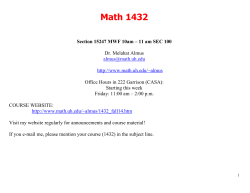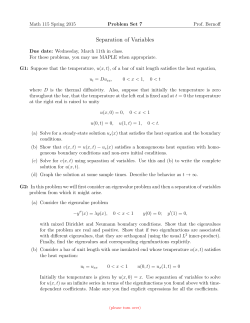
Extra Credit Problem Set (BSM chapter)
Extra Credit Problem Set (BSM chapter) Problem 14.11. Assume that a non-dividend-paying stock has an expected return of µ and a volatility of σ. An innovative financial institution has just announced that it will trade a derivative that pays off a dollar amount equal to ln ST at time T where ST denotes the value of the stock price at time T . 1. Use risk-neutral valuation to calculate the price of the derivative at time t in terms of the stock price, S, at time t. 2. Confirm that your price satisfies the differential equation (14.16). (1) At time t, the expected value of ln ST can be determined by applying equation (14.3): E(ln ST ) = ln St + (µ − σ 2 /2)(T − t). We obtain the risk neutral expected value of ln ST by simply replacing the expected return (µ) with the riskless rate of return (r ). The logic behind this parameter substitution is the notion that in a risk-neutral world, investors do not require compensation for bearing risk; they only expect to be compensated for the time value of money. Thus, ˆ ST ) = ln St + (r − σ 2 /2)(T − t), E(ln ˆ operator indicates a risk neutral expected value. Using risk-neutral where the E(·) valuation, the value of the derivative at time t is ˆ ST ) = e−r(T −t) [ln S + (r − σ 2 /2)(T − t)]. f = e−r(T −t) E(ln (2) The Black-Scholes-Merton differential equation (14.16) is ∂f ∂f 1 ∂ 2f + rS + σ 2 S 2 2 = rf. ∂t ∂S 2 ∂S Since we are interested in confirming that the pricing equation given by f = e−r(T −t) [ln S + (r − σ 2 /2)(T − t)] satisfies this differential equation, we need to calculate the following set of partial derivatives for f : ∂f = re−r(T −t) [ln S + (r − σ 2 /2)(T − t)] − e−r(T −t) r − σ 2 /2 , ∂t ∂f e−r(T −t) ∂ 2f e−r(T −t) = , and = − . ∂S S ∂S 2 S2 ∂f ∂f ∂ 2f ), delta ( ), and gamma ( 2 ) into the ∂t ∂S ∂S left-hand side of equation (14.16), we obtain: Substituting our expressions for theta ( e−r(T −t) [r ln S + r(r − σ 2 /2)(T − t) − (r − σ 2 /2) + r − σ 2 /2] = re−r(T −t) [ln S + r(r − σ 2 /2)(T − t)] = rf. Hence the differential equation is satisfied. 1 Problem 14.28. A financial institution plans to offer a security that pays off a dollar amount equal to ST2 at time T . 1. Use risk-neutral valuation to calculate the price of the security at time t in terms of the stock price, S, at time t. (Hint: The expected value of ST2 can be calculated from the mean and variance of ST given in section 13.1.) 2. Confirm that your price satisfies the differential equation (14.16). (1) The expected value of the payoff on this security is E[(ST )2 ]. From equations (14.4) and (14.5), at time t : E(ST ) = Seµ(T −t) var(ST ) = S 2 e2µ(T −t) [eσ 2 (T −t) − 1] The general definition for V ar (ST )is: V ar (ST ) = E[(ST − E(ST ))2 ] = E[(ST )2 + E(ST )2 − 2ST E(ST )] = E[(ST )2 ] + [E(ST )]2 − 2[E(ST )]2 = E[(ST )2 ] − [E(ST )]2 . Solving for E[(ST )2 ], we obtain E[(ST )2 ] = V ar (ST ) + [E(ST )]2 . Therefore, E[(ST )2 ]=St2 e2µ(T −t) (eσ 2 (T −t) − 1) + St2 e2µ(T −t) = St2 e(2µ+σ 2 )(T −t) . In a risk-neutral world µ = r; thus, ˆ T )2 ] = S 2 e(2r+σ2 )(T −t) E[(S Using risk-neutral valuation, the value of the derivative security at time t is ˆ T )2 ] = S 2 e(2r+σ f = e−r(T −t) E[(S 2 )(T −t) e−r(T −t) = S 2 e(r+σ 2 )(T −t) (2) The Black-Scholes-Merton differential equation (14.16) is ∂f 1 ∂ 2f ∂f + rS + σ 2 S 2 2 = rf. ∂t ∂S 2 ∂S Since we are interested in confirming that the pricing equation given by 2 f = S 2 e(r+σ )(T −t) satisfies this differential equation, we need to calculate the following set of partial derivatives for f : ∂f 2 = −S 2 (r + σ 2 )e(r+σ )(T −t) , ∂t 2 ∂f 2 = 2Se(r+σ )(T −t) , and ∂S ∂ 2f 2 = 2e(r+σ )(T −t) . 2 ∂S ∂f ∂ 2f ∂f ), delta ( ), and gamma ( 2 ) into the ∂t ∂S ∂S left-hand side of equation (14.16), we obtain: Substituting our expressions for theta ( −S 2 (r + σ 2 )e(r+σ 2 )(T −t) + 2rS 2 e(r+σ 2 )(T −t) + σ 2 S 2 e(r+σ Hence the Black-Scholes-Merton equation is satisfied. 3 2 )(T −t) = rS 2 e(r+σ 2 )(T −t) = rf
© Copyright 2025





















